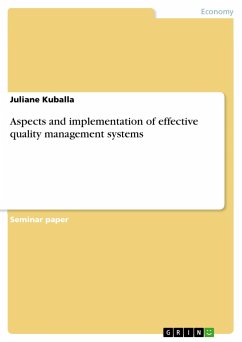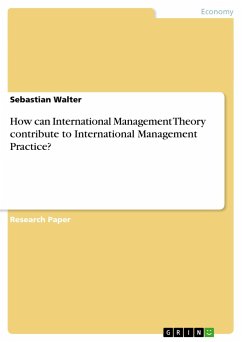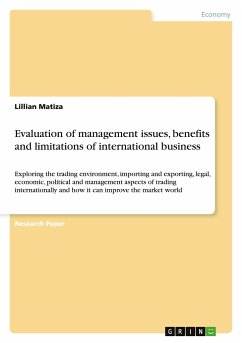
International Management

PAYBACK Punkte
0 °P sammeln!
Seminar paper from the year 2006 in the subject Business economics - Business Management, Corporate Governance, grade: 1,7, Pforzheim University, course: International Management, language: English, abstract: Modern companies are trying to gain an advantage over their competitors. Mostof them are finding that a good way to gain such an advantage is through thecomplex process of going global. By doing so, enterprises can extend theirproduct lines to other countries and cultures. They can also save money onlabour costs by taking advantage of the lower standard of living in somecountries. Global ...
Seminar paper from the year 2006 in the subject Business economics - Business Management, Corporate Governance, grade: 1,7, Pforzheim University, course: International Management, language: English, abstract: Modern companies are trying to gain an advantage over their competitors. Mostof them are finding that a good way to gain such an advantage is through thecomplex process of going global. By doing so, enterprises can extend theirproduct lines to other countries and cultures. They can also save money onlabour costs by taking advantage of the lower standard of living in somecountries. Global expansion enables a company to add value by transferringcore skills overseas, using global volume to cover product development costs,realizing economies of scale from global volume, and configuring value-creationfunctions in locations where value added is maximized. Companies pursuingglobal strategies can gain cost economies by integrating manufacturing,marketing, and competitive strategies across national boundaries, but they mustgive up a certain degree of responsiveness to national conditions.This study looks at the strategies companies adopt when they expand outsidetheir domestic marketplace and start to compete on a global basis.The first chapter starts with a discussion how global expansion createsimportant values for companies.The second chapter examines different strategies which companies can pursuein the global arena. These four different strategies are reviewed in detail - theinternational strategy, the multidomestic strategy, the global strategy, and lastbut not least the transnational strategy. Furthermore the pros and cons of eachof these strategies are debated. In addition the link between theappropriateness of different strategies and the pressures of cost reductions andlocal responsiveness is made.In the next section the various basic options a company has for entering aforeign market - exporting, licensing, strategic alliances, joint ventures,franchising, turnkey projects, foreign direct investment, acquisitions and theestablishment of a wholly owned subsidiary as well as e-Commerce - arereviewed in detail. Finally, the last section gives a brief summary with importantconcluding remarks.













